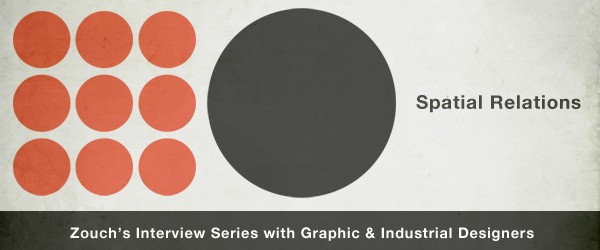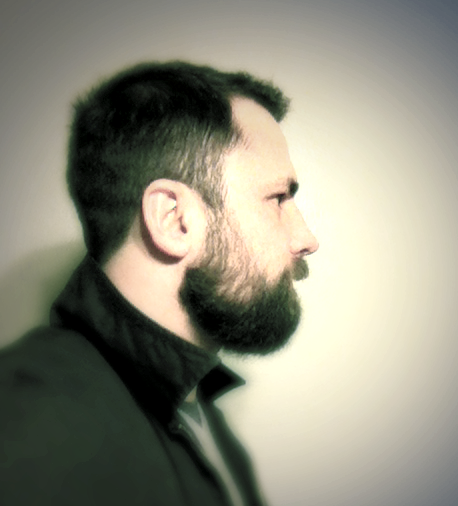
Spatial Relations #2 – An Interview with Dominic Muttel
Interviews, Spatial RelationsDominic Muttel is a photographer, designer, and artist based in Colorado.
Dominic is a “post movement” designer who cut his teeth on skateboards and reads the contemporary design landscape like a mathematician. (It’s “exponential,” he says.) Dominic suggests designers and artists should be aware of the dynamics of placement and function and feels the work of Frank Gehry and Daniel Libeskind represents a certain “vanity of action.”
Andy Warhol and Marcel Duchamp — two members of Dominic’s design dream team — would probably have one or two things to say about this.
1) What made you want to become a graphic or industrial designer?
As kids, my friends and I skateboarded so, we were always looking for the next fresh graphic. You wanted to have the freshest deck. In my late teens I picked up a typography magazine at a local bookstore, which had a feature on what font face would be used for the WTC monument that listed the names of the deceased. I found it fascinating that they were having board meetings over a font and how the font had to hold the dignity of such a tragic episode of innocence. This really got me hooked on the formal aesthetics of typography and how it functioned.
2) Who are your influences?
Sagmeister and Walsh, Diller Scofidio + Renfro, Bruce Mau, Rori Knudtson, Gabriel Kuri, Le Corbusier, OMA, Hiroshi Sugimoto, Techno Music, Agent, & Kofin (Graffiti Vandals).
3) What design movement(s) do you most identify with?
I am finding this one hard … I really feel close to the Minimalist movement with some Post-Modern and Modernism elements. Maybe some Dada in there … Bauhaus? I think the rhetorical end of this for me is that we live post-movement, in a sense, and I have utilized all the past movements in my designs. So, it is hard to answer what movement I identify myself with specifically.
4) How would you describe your “process”?
My process is pretty pragmatic because I will be both researching and designing simultaneously. I have no problem scrapping an idea. The most important part of my process is that I never take anything personally. My process always includes lots of music and coffee anyway it goes.
5) What work(s) or project(s) do you consider your masterpiece(s)?
My work at Emmanuel Gallery was some of my favorite work. The gallery director, Shannon Corrigan would just let me go to town creating as I saw fit. Her trust helped make some great stuff and gave me a lot of confidence.
6) What are you working on right now?
I am developing and interactive webpage for SoCE as well as revamping their website. I am also, helping SoCE with a video project and some odds and ends. Also, I have a couple clients I am working on identities with and later this spring will be completing their websites. Dare I say: some personal work on top of all of the above.
7) What’s your next project?
After these clients I will be taking a break to work on some personal projects. The focus will be on the plasticity of nature. I have been exploring all types of materials and the show is going to range enormously in media. There will be sculpture, video, print, interactive components, and who knows …
8) How would you describe or categorize contemporary design?
I would describe it as exponential. The resources we have now are allowing for individuals to learn design that normally wouldn’t have had a chance to in the past. As I stated earlier we have also worked from and have access to all the past movements of design to learn from. Anyone can access this information. I think it is an amazing age to be a designer.
9) What design movement(s) or designers do you dislike?
Frank Gehry and Daniel Libeskind. Anyone who capitalizes on a form before they look at the dynamics of where it is to be placed and how it can function as much more than just a pretty object. I think the term is “capital A, Architects,” with the “A” standing for something derogatory. This goes for all types of design that we should be looking at more than just the vanity of our actions. You will always have a tendency to make some things that are pure vanity but try and stray from this and aim for a higher standard.
10) What characterizes your work or style?
Minimal n’ Clean
11) What is the most beautiful man-made thing you’ve ever seen?
Honestly, The High Line in New York. The back-story of The High Line is fantastic. What it has become as a function of economics, how it has facilitated voyeurism, and mostly, the ability to walk un-abruptly for thirteen miles in one of the mostly densely populated cities in America makes this a truly fascinating mark on civilization. I first walked The High Line with one of my best friends and had the opportunity to explain some of the concepts behind the project that he was unfamiliar with. As well, it was designed by my favorite architecture firm Diller Scofidio + Renfro. I suggest getting some of Diller Scofidio + Renfro’s literature and taking a look at their multilayered, dynamic approach to Architecture.
12) What’s the most exciting thing about your profession?
By far the diversity of where you can take your talent. It is so endless.
13) Which designer(s) should we keep an eye on?
I have no idea. Just look at what you like and the designers that are creating it. But, always keep digging to find new designers and new inspiration.
14) Who would be on your “fantasy design team”?
Edward Tufte, Rori Knudtson, Donald Judd, David Adjaye, Andy Warhol, Rem Koolhaus, Alexander Rodchenko, Benjamin Dayton, & Marcel Duchamp.

Dominic Muttel is a photographer, designer and artist. The inclusion of these facets allows for him to create developed minimal designs focused on his clients needs. He commits his time as a freelance designer servicing his clients with identity, branding, and web design under the name DOMU. He has worked with the School of Critical Engagement (SoCE) part-time since 2010, in Copenhagen, Los Angeles and Denver and is currently working for a small advertising newspaper. He has a BFA in Photography from University of Colorado Denver and is currently honing his Spanish skills so that he can start applying to architecture graduate programs in South America and Mexico.
Dominic Muttel is the youngest of seven and his family lives throughout the United States and the UK. He has traveled to Belize, Mexico, United Kingdom, France, Germany, Italy, Netherlands, Luxembourg, Switzerland, Denmark, Norway, and Sweden. He spent a year in Los Angeles developing large-scale social engagement projects with SoCE. His unique experiences have helped in developing him as an artist and designer. Love, relationships, music, traveling, cats, architecture, space, food, and pop-culture constantly motivate him to create new projects ranging in media.
You can view his portfolio at: www.domuconcept.com and some of his abstract work at: www.cargocollective.com/dofran and some of the School of Critical Engagement’s work at: www.schoolofcriticalengagement.org.






















